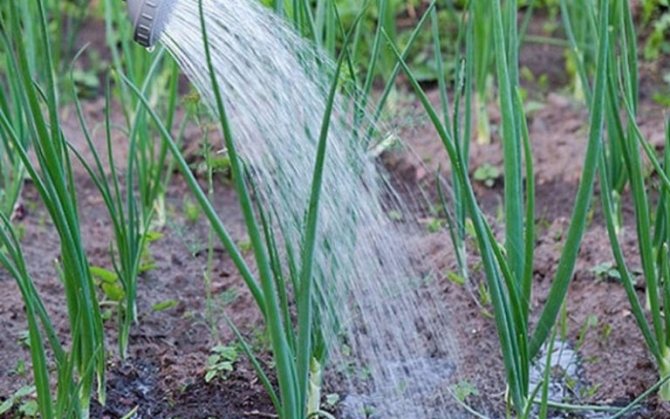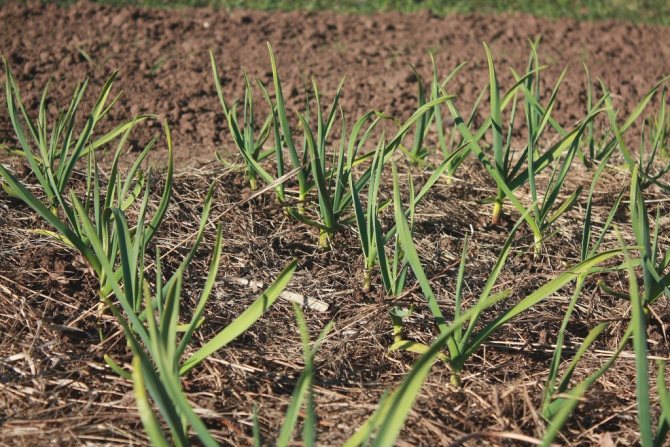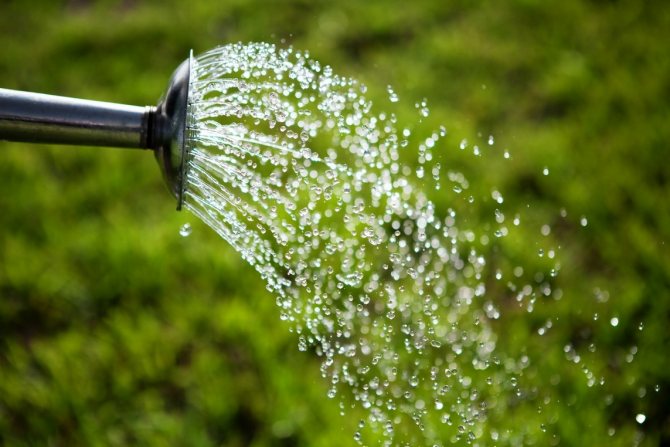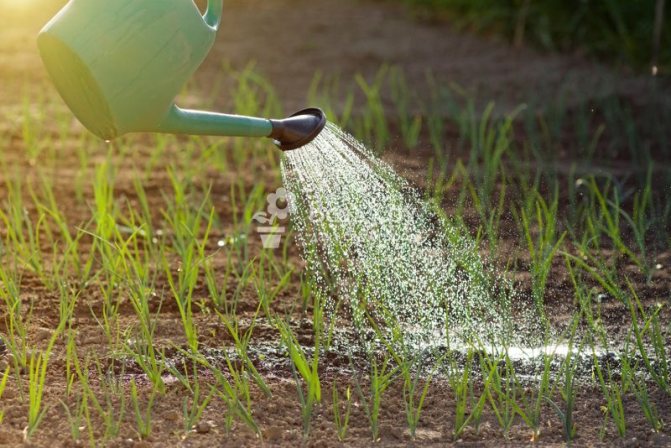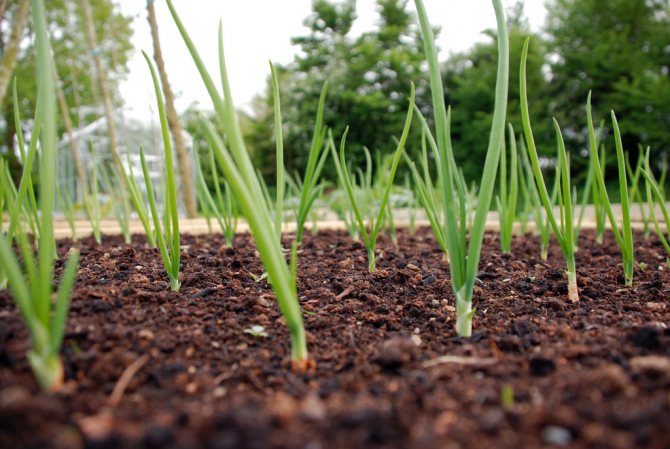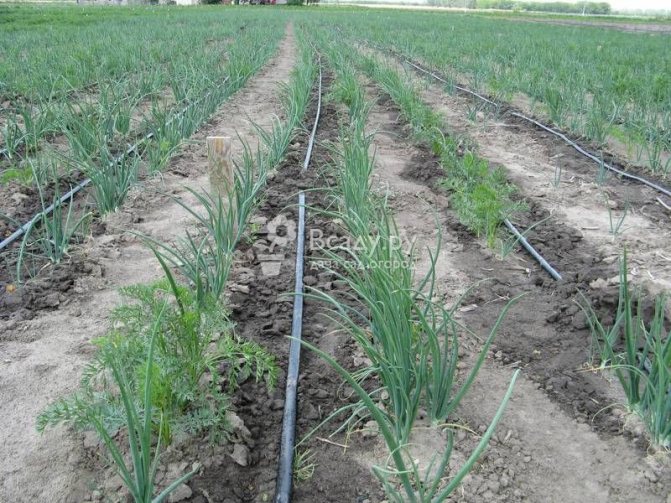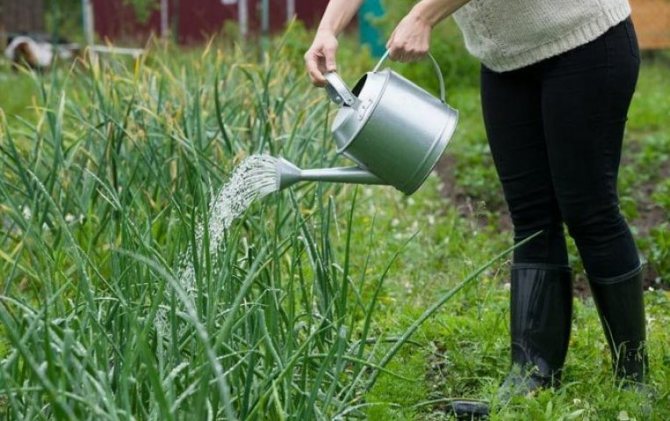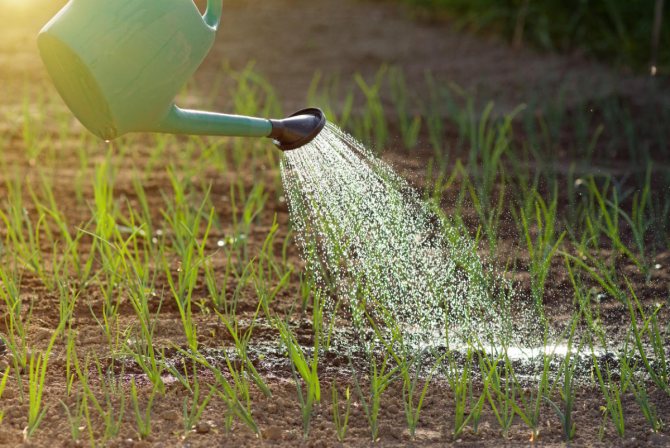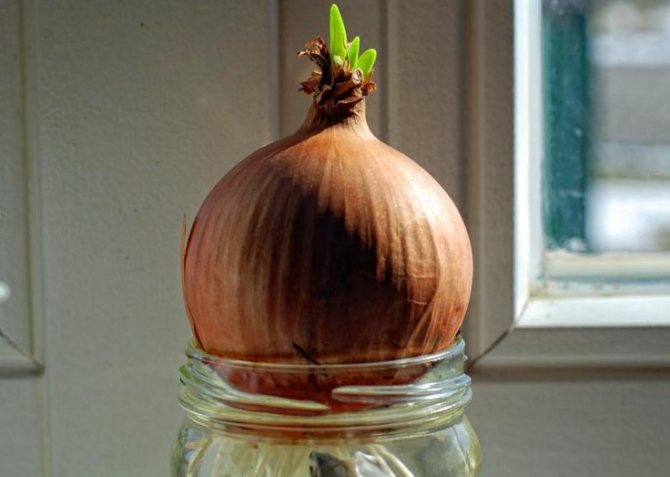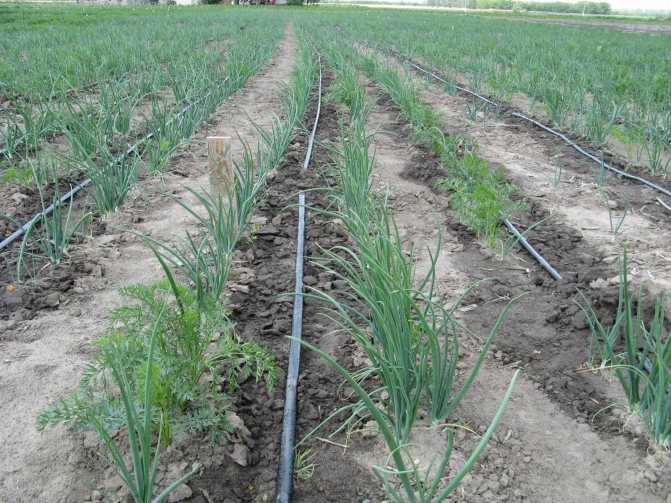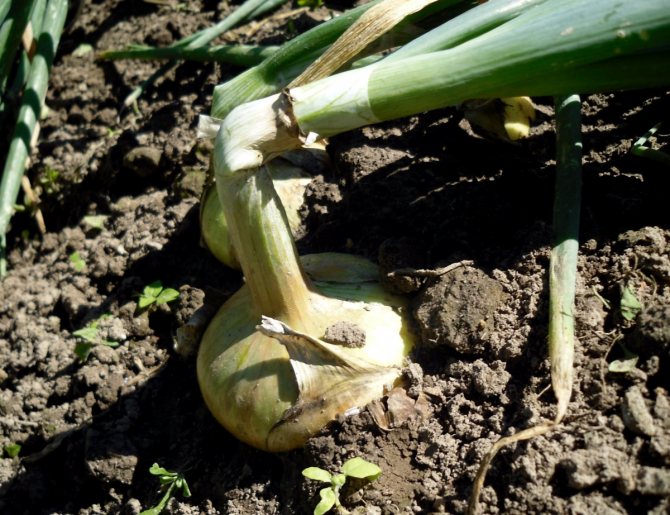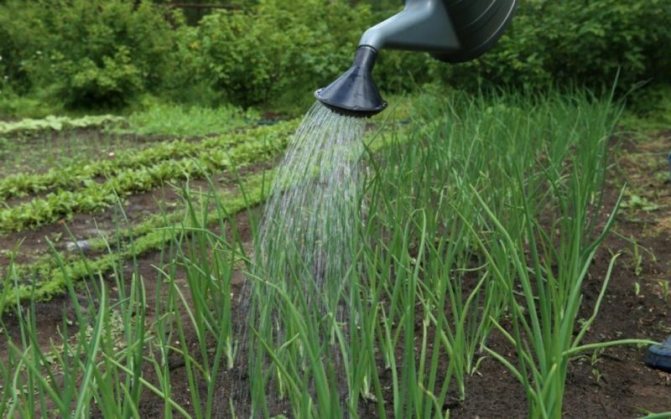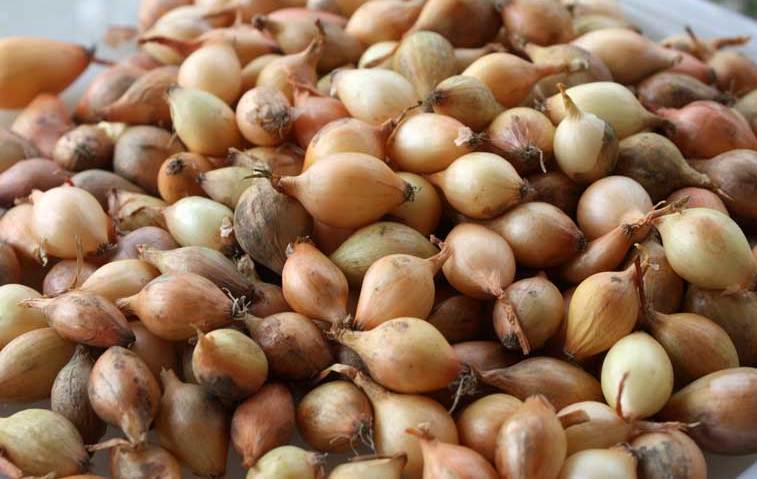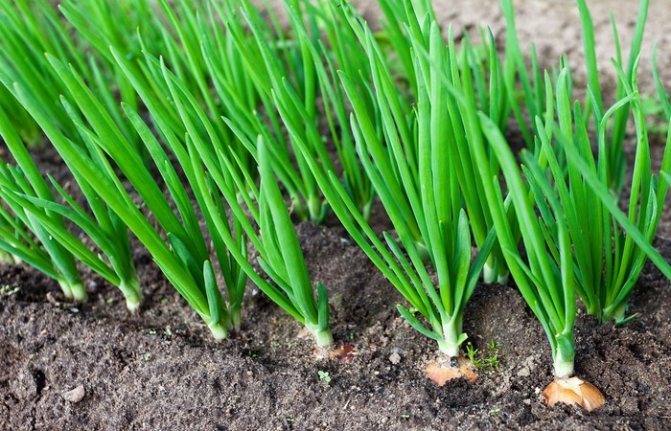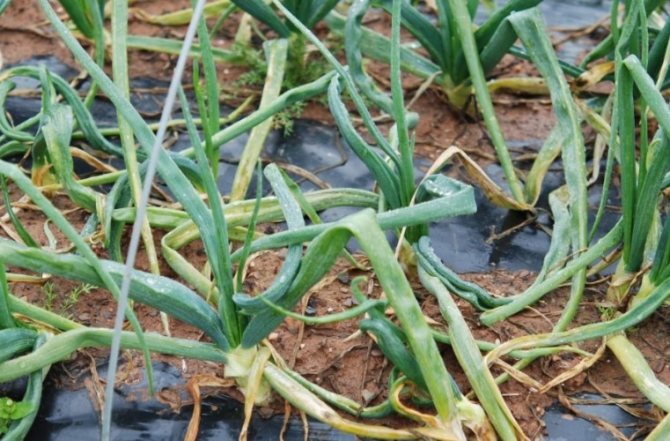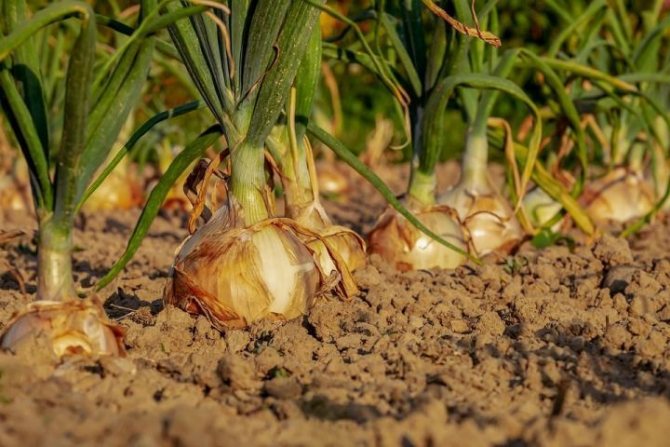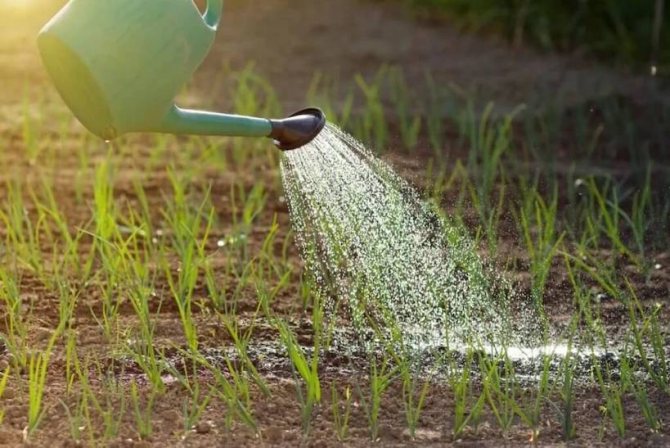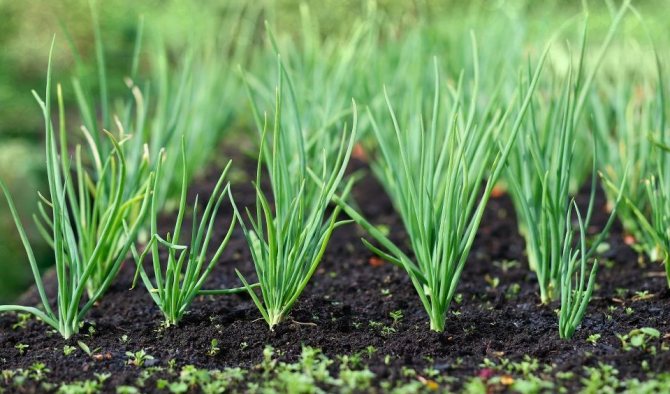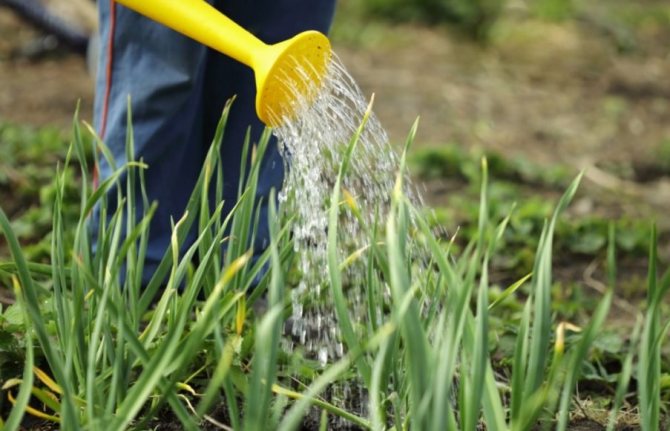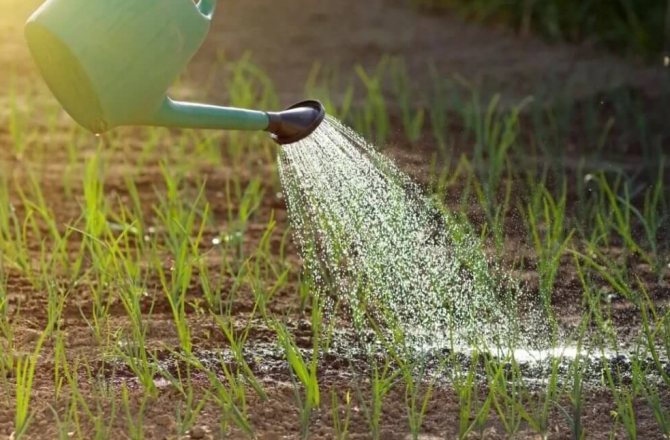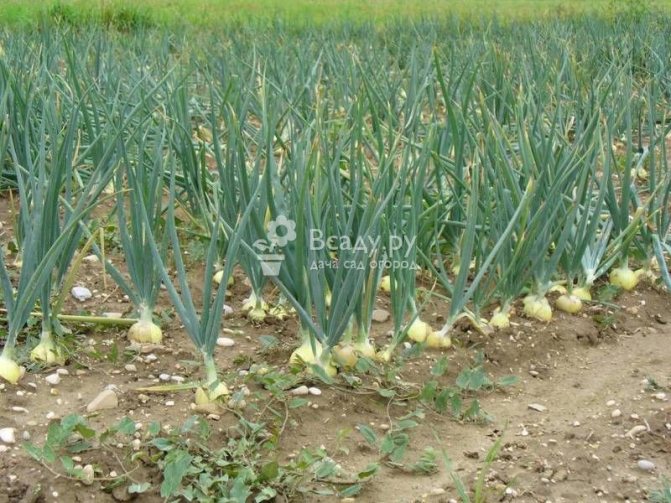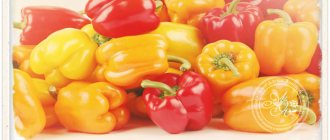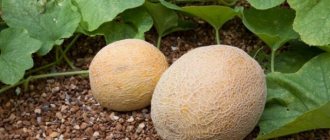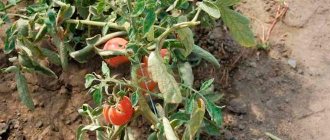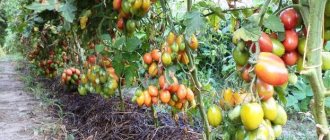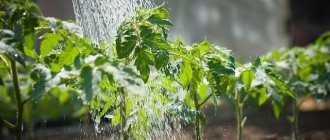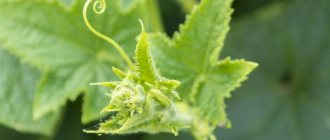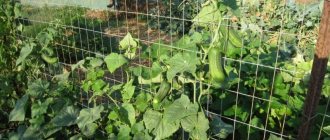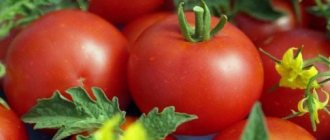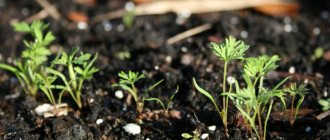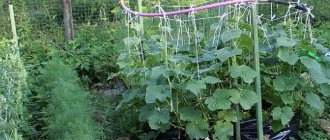General rules and norms for watering onions
Onions are a stable and non-capricious crop, but for normal growth they need a suitable planting site and an optimal irrigation regime.
Why water onions
The vegetative parts of the plant are, on average, 90% water. The size of the bulbs directly depends on the timeliness and amount of watering. To increase organic matter (both turnip and greens), onions require a lot of nutrition. Water provides plants with access to nutrients that need to arrive regularly and evenly.
Lack of moisture serves as a signal to stop the vegetative process and start ripening of the bulbs.
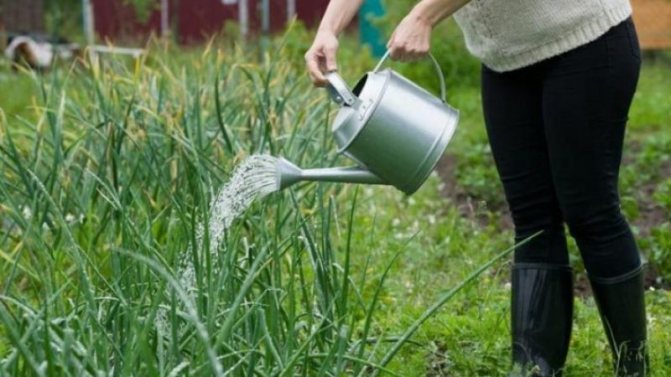
When and how often
Especially important is the moisture schedule at the stages of root formation, leaf mass growth and the bulb itself.
After planting, the plant is actively watered. During this period, the soil moisture indicator is maintained within 70%. As soon as the bulbs reach the optimal varietal size, watering is reduced, and at the stage of ripening, they stop altogether.
Important! They take warm water for irrigation. Fresh well or tap water is not used without preliminary infusion. The approximate norm is a bucket of liquid per 1 m2 of plantings. This volume is adjusted for rainfall and soil conditions.
When forcing on a feather, the onion is moistened throughout the growing season.
When to stop watering onions
Two months after planting, the onion stops growing and begins to actively accumulate sucrose and nutrients. He no longer needs moisture - it will only interfere with the maturation of the heads, so watering onions in July is completely stopped.
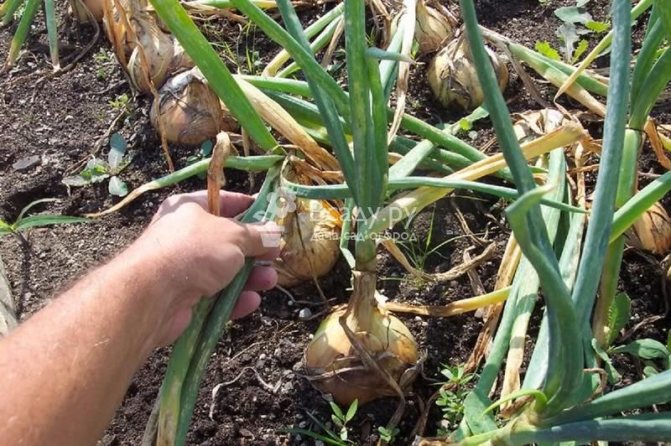

The beginning of ripening of onion heads is a signal to stop watering
From the middle of summer, onion feathers fall on the ground. The upper scales of the heads dry out and form a golden husk. After these processes, the crop is ready to be harvested.
For a long time, the people of Peter and Paul, July 12, have been considered a guideline when to stop watering onions on a turnip. If watering continues, the crop may start to rot while still in the ground. The onion that has saturated water is stored very poorly.
How to water properly
Proper watering ensures constant uniform soil moisture to the depth of the root system spreading without the formation of a soil crust and moisture stagnation. Onion irrigation methods are sparing: sprinkling (for greenery), between rows (for turnip), drip method.
In the open field
Atmospheric and soil processes significantly affect the moisture schedule of vegetable beds. The need for the next watering is determined by checking the condition of the soil at a depth of several centimeters.
Attention! It is important to avoid spilling liquid on the bulbs so that they do not start to rot. The regulation of the water pressure will not allow the soil to erode.
Vegetables are irrigated in the morning or evening, not in hot weather. This will prevent leaf burns and the soil from drying out quickly. The water is used warm (+ 17 ... + 18 ° C).
In the greenhouse
Onion cultivation in protected ground is practiced year-round, mainly for forcing high-quality abundant greens (per feather)... In addition to the usual onion, perennial varieties are used: leeks, batun, shallots and others.
Onions are planted on a feather more densely than on a turnip. Water the culture from a watering can (sprinkling) with warm water as the soil dries up.Usually humidified less often than outdoors (in dry weather), since there is less ventilation in greenhouses and constant air humidity is maintained. In some greenhouses, onions are grown hydroponically.
Drip irrigation
Drip irrigation is the most effective method because:
- prevents the risks of waterlogging and soil erosion;
- significantly saves water resources, including reducing waste water losses;
- allows dosed fertilization;
- protects bulbs and feathers from burns and getting wet;
- maintains good soil characteristics: mineral composition, looseness, etc.
Simultaneously with drip irrigation, fertigation is carried out (the culture is fed with liquid fertilizers).
Basic rules for outdoor watering
It is recommended to moisten the beds in the morning or evening. Because plants can get burned if water drops on the leaves on a hot sunny day.
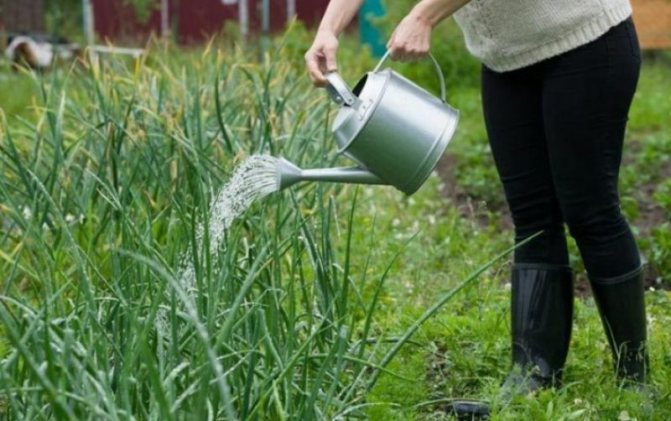

It is imperative to put a watering can clamp on the hose. Otherwise, it is easy to wash off the surface fertile soil and onion heads with a strong pressure of water. It is also not recommended to throw water out of the bucket, otherwise the set will be washed out and will not be able to take root.
Properly watering the culture with warm water - this stimulates the growth of root crops, reduces the likelihood of the appearance of fungi and bacteria. The water is not specially heated. It is enough to install a water tank connected to the irrigation system in a well-lit place. Acceptable water temperature is 15-17 ° С. The barrel is filled with water and in a day and a half you can start watering the beds.
If the garden or dacha is located in a lowland / damp place, then create high beds for onions. When forming the ridge, the bottom layer must be made drainage (using expanded clay, brick chips, small pebbles or crushed stone).
How to water at different stages of the growing season
The main secrets are varying watering rates at different stages of growth.
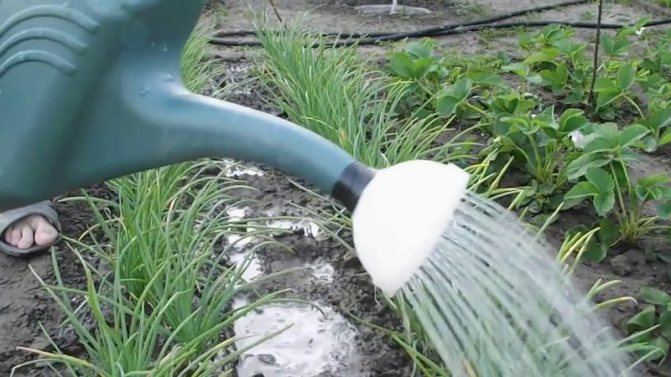

Before boarding
Before planting onions, the soil is shed to a great depth with a double dose of liquid. It is advisable to use not just water, but a weak solution of potassium permanganate for disinfection.
With such abundant watering, the seedlings are planted the next day, when the soil reaches optimum moisture content.
With early spring planting, when there is still a lot of natural moisture in the ground, pre-planting irrigation of the beds is not necessary.
Immediately after landing
After planting the seed, the soil is moistened to start the growing processes. Even with an autumn planting before winter, the set must take root before leaving "to rest" until spring.
When seedlings appear and during a period of active growth
It is important for onions that the soil layer at a depth of 10 cm remains evenly moist.
Attention! The main thing in determining the need for watering is the dryness of the soil in the root layer. It is unacceptable to bring to the appearance of cracks on the surface of the earth.
In the open air, the frequency of irrigation is determined depending on weather conditions (in the absence of rain - 1-2 times a week). In the greenhouse, watered every 10 days.
Bow on feather
Feathers form succulent if there are enough nutrients in the bulb. Water the culture abundantly throughout the entire period of greenery growth (taking into account the temperature conditions in the greenhouse). At rates of about + 15 ... + 20 ° С, water is watered moderately, once a week, on average, 3 liters per 1 m2. With a significant increase in air temperature (more than + 25 ° C), both the frequency of humidification (once every 4-5 days) and the volume of liquid (3-4 liters per 1 m2) are increased.
Before harvest
The intensity of watering is reduced when the peak of growth processes passes. Lodging of tops in 30–40% of plants serves as a signal for a decrease in moisture. There is no need to stimulate the growth of new leaves.During this period, nutrients move from the green mass and are concentrated in the bulb. When the feathers begin to actively turn yellow and dry out, watering is stopped altogether.
How to water a large onion
The peculiarity of irrigation of grown onions is associated with the need to protect the already formed heads from getting wet. Rain and root methods of planting moistening are replaced by irrigation technique between rows.
The soil in onion plantings is loosened superficially so as not to damage the roots lying in the upper layer.
General rules
Watering is necessary, because the plant instantly reacts to any changes in the climate and in the soil. If the bulb is in dry and not moistened soil for a long time, it simply stops growing greens and feeds the tuber itself.
To harvest a quality crop, adhere to the rules for irrigating the beds, which include the following points:
- make sure that water does not get on the bulb itself and its leaves;
- the soil should be saturated with water to a depth of 20 cm;
- make sure that a soil crust does not appear;
- use water for irrigation, the temperature of which is from +14 to +17 degrees;
- water the beds in the evening;
- the most effective irrigation method is a drip system;
- stop watering a few weeks before harvest.
From the moment of planting, the onions are watered for about two months, and the frequency depends on the level of soil moisture and weather conditions.
In the greenhouse
To get the onion harvest as early as possible, the crop is planted in greenhouses. Greenhouse conditions make it possible to grow onions at any time of the year, the main thing is to take into account the peculiarities of watering:
- moisten the soil on the eve of planting, and for better moisture retention, mix the soil with sawdust;
- on the day of planting, water the first with a warm, weak solution of manganese;
- a week later, water the beds using the ecological biological product Fitosporin M (1 tablespoon per bucket of water);
- subsequent watering is carried out only if the soil dries out (the water temperature is +17 degrees);
- then, based on the temperature values, determine how often you need to water: at + 15-20 - once every 10 days, above +25 - once every 4 days;
- check the quality and condition of the soil and, depending on this, determine the required volume of water.
Fulfilling such simple conditions, you will be able to harvest in 25-30 days.
In the open field
Watering onions in the open field is a more complicated process than in greenhouses, since in the latter case, soil moisture is easier to control. Under the influence of the sun and wind, open ground dries out faster, which has a direct impact on the yield of onions. To obtain an annual stable harvest, it is recommended to have a notebook in which to draw up an irrigation schedule.
For the first time, the soil is watered just before planting. Such watering is needed to settle the soil so that the planted onions do not then appear on the surface. Use about 20 liters of water per square meter.
After that, make grooves for planting and spill them, and then proceed directly to planting the onion. Sprinkle soil on the crop and water it for the first time. Use water for irrigation with the addition of Fitosporin or potassium permanganate to disinfect the soil:
- Fitosporin added in the amount indicated on the packaging of the drug;
- potassium permanganate diluted in water to form a pale pink solution.
Until a green feather appears (5-10 cm), you do not need to water the onion. Then water the plants until the water sinks into the ground, and loosen the soil the next day.
In the future, irrigate no more than once a week and pay attention to the weather conditions:
- in dry, dry weather, onions need one watering per week;
- after heavy rains, water the beds no earlier than a week after their completion;
- if the weather was hot but it rained a little, water on schedule as if it hadn't rained at all.
After the beginning of the formation of the bulbs and the breaking off of their arrows, mandatory watering is carried out, since when the arrows are formed, the bulb practically stops pouring, and all moisture goes into this very arrow.
Next, based on the ripening level of the onions, you should determine when to stop watering completely.
Overflow hazard
Despite the increased need for water onions, at certain stages of growth, it is important not to overdo it with moisture.
Attention! Excessive watering, especially on heavy soils, promotes the development of rot in plants.
With an excess of moisture, the bushes are affected by powdery mildew, the bulbs crack, weeping areas appear on them. When the first signs of damage appear, irrigation is stopped.
When to stop watering
For full ripening of the bulbs 1-2 weeks before harvesting watering is stopped (approximately from the end of July - beginning of August).
The time for collecting green feathers comes when they reach the required length. In this case, they stop moistening the culture 2-3 days before the intended cutting, so that the feathers do not deteriorate from the liquid.
What water to water onions
The main component of an onion is its head, a bulb that requires a sufficient amount of moisture to develop. If it is not enough, the process of bulb formation will stop, which will lead to a crop failure. Therefore, periodically the onion needs watering.
It should be used with warm water with a temperature in the range of 16-18 ° C. Water of this temperature can be obtained if a storage tank (barrel) is installed on the territory of the site. Liquid can be poured into it with a hose from a water supply system or a bucket from a well. The water is left in a barrel for 1-2 days to warm up in the sun, then it can be used for watering.
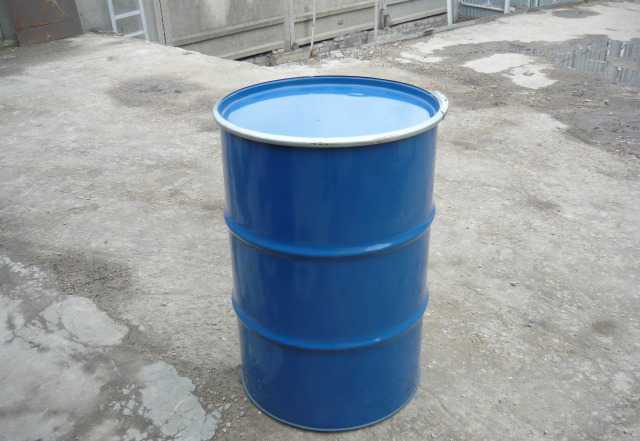

The water in the barrel is heated by the sun and used for irrigation
The temperature of the water in the barrel will be about the same as the ambient temperature near the bulbs, and they will not experience the stress of sudden changes in temperature. Cold liquid causes damage to the vegetable crop by various fungi and bacteria, for example, downy mildew.
How and why to water onions with a nutrient mixture
The onion selects a large supply of nutrients from the soil, therefore, fertilizing irrigation has a beneficial effect on it.
Salty water
Often, gardeners fertilize onion plantings with salt water. It is affordable and economical, and salt not only contains elements beneficial to the culture, but also repels harmful insects (for example, onion flies).
For protection and feeding, plants are watered with salt water no more than 3 times per season with an interval of 2-3 weeks. For the solution, take 200-300 g of salt in a bucket of water. Pour at the root.
Important! Frequent watering with salt water deteriorates the quality of the soil, salting it. To neutralize this negative effect, at the end of the season, a double portion of organic fertilizers is applied to the beds.
A few hours after this treatment, the bed is irrigated with ordinary heated water.
Water with dressing
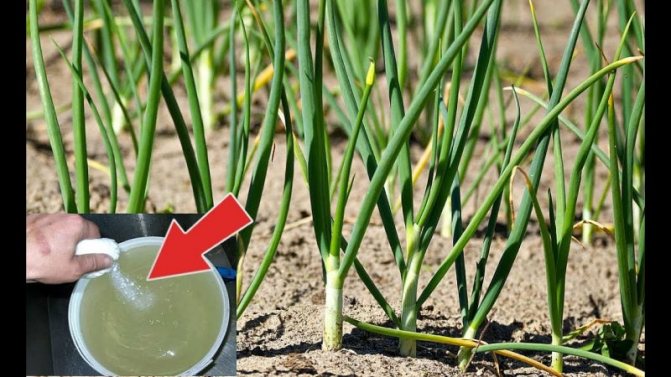

With good pre-planting fertilization of the beds, the first root dressing is applied after 2-3 weeks. It is better to use organic fertilizer, since at first onions need nitrogen.
Until the end of July, under normal planting conditions, complex fertilizers are added with the same frequency. If signs of starvation appear (feather blanching, slow development of bulbs), the composition and sequence of dressings are adjusted.
How to properly water the onion?
When wetting onion beds, you must follow the rules of technology. You should not water the plant just from a hose, since you can wash off the surface of the earth with a stream of water and not only damage the heads, but also wash them off altogether. Therefore, a watering can-shaped retainer is put on the hose. Also, the water pressure does not need to be made strong.You need to water the culture in the morning or in the evening. Despite the fact that onion feathers are endowed with a coarse fabric, water droplets left on the stems on a hot day can cause burns. Since they turn into a kind of lenses in the sun.
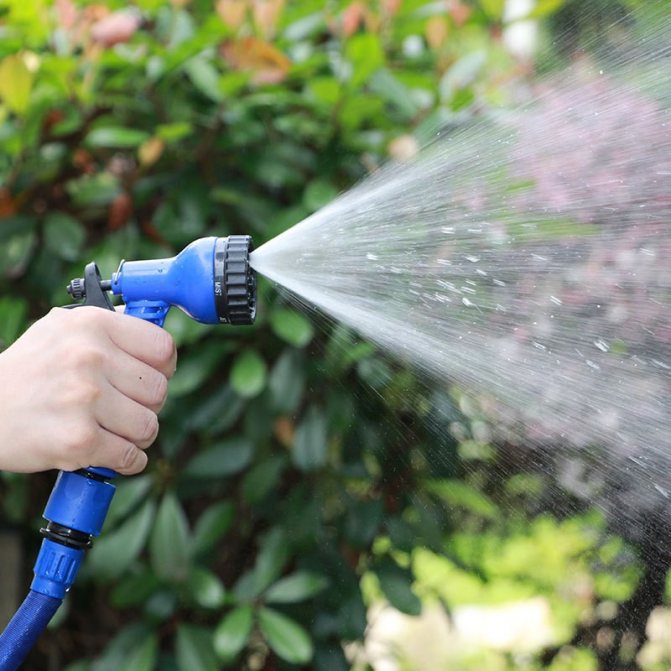

Watering large onion heads
After the onion grows up and its root crop reaches a diameter of up to 5 cm, you will need to change the watering method. During this period, the nozzle is removed from the hose and the water pressure is made even less. The large onion heads are watered by guiding the hose between the rows.
Irrigation water: what can you use?
To grow large onion heads, you must have a storage tank, which is installed next to the beds on a hill. You can buy, for example, a metal tank in the form of a box. It can be welded from sheet metal. The container is filled with water taken from a well, well, digging hole. To warm it up, leave it for several days. Then onions and other garden crops are watered. The water heated in this way promotes better growth of root crops and reduces the possibility of the appearance of various bacteria and fungi on the cultures. Warm water does not stress the bulbous stems.
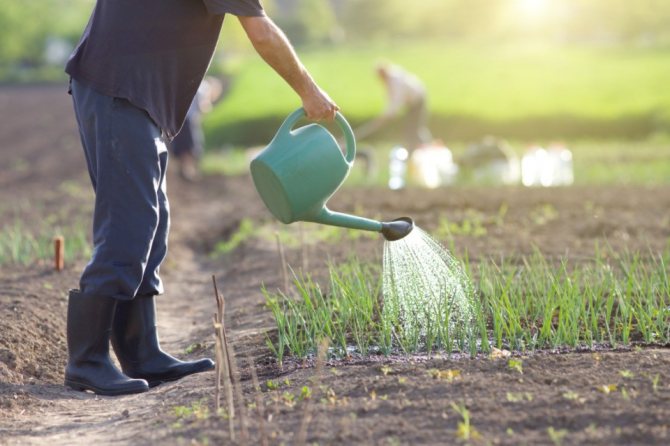

Why is waterlogging dangerous?
Watering onions, like other vegetable crops, you must adhere to watering norms. First, the plant does not tolerate drought. Simply put, without regular moisture it will not be possible to get a good harvest. However, overflows are not allowed. With constant waterlogging, the root crop will begin to rot. Among other things, the swampy environment will create conditions for the multiplication of fungi and diseases. So, on too wet beds, powdery mildew can quickly appear. And if you harvest a crop, then it will not be stored for a long time. After 2-3 months, the bulbs will begin to rot, starting from the roots.
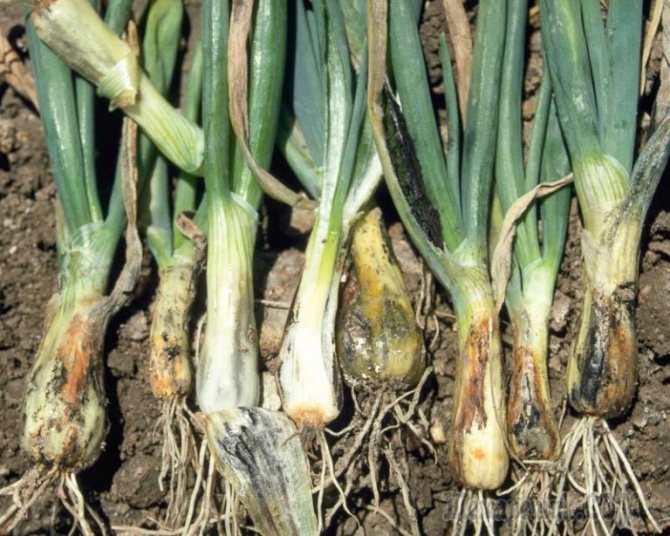

If the garden is located in a damp place, raised beds are made for onions. You can dig ditches in the garden to drain water by placing perforated pipes in them. This will provide drainage. This method will increase the yield of not only onions, but also other vegetable plants.
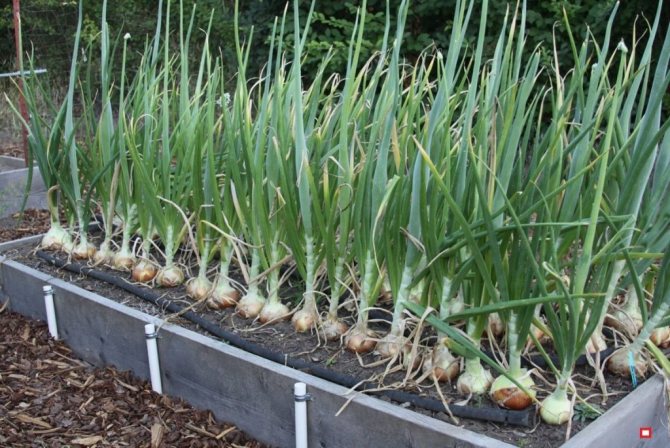

The required volume of water for irrigation
Usually, the onion is moistened quite abundantly. Although it all depends on the period of growth of the culture. And yet the soil must be soaked so that moisture reaches all the roots, which are known to be of different lengths. One square meter of onion beds will need 10 liters of water. The ground must be moistened to a depth of at least 15 cm.
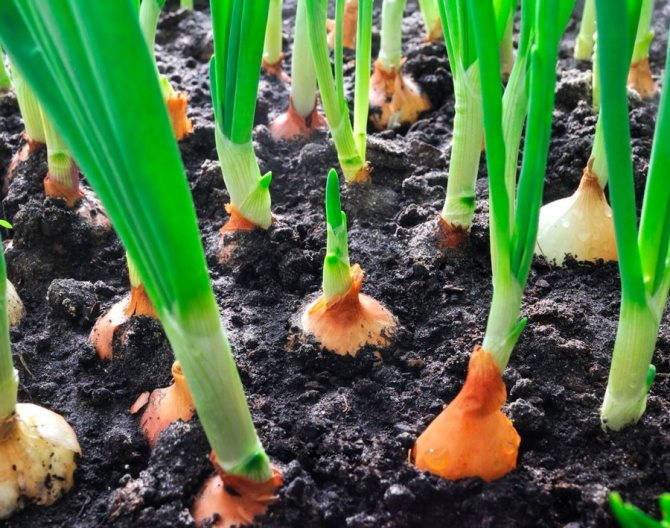

After planting, the onions are moistened to a lesser extent. In addition, two weeks later, as the beds with onions were formed, the site can be mulched with rotted compost or manure. But this should be done after moisturizing. Previously, the soil is loosened, removing weeds, and then covered with a 4-5 cm layer of mulch.
Watering onions with nutrient solutions
Of course, in a garden bed that has been mulched with compost or manure, onions will grow faster, but feeding in the form of nutrient mixtures that will need to be added during the growing season will not interfere with the culture. Mullein supplements can be used. It is bred in water and the onion beds are watered very carefully. The proportion is 1 to 10. Care should be taken not to get the solution onto the green mass.
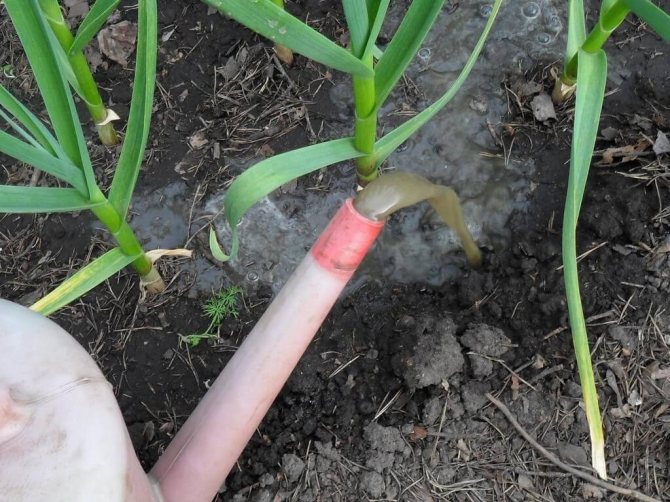

Watering onions in a greenhouse
Very often summer residents plant onions in greenhouses in order to have the first vitamins on the table in early spring. Root feathers grow quickly. However, you need to water the crop correctly. Greenhouse onions are moistened every 3-4 days.
When growing vegetables in a greenhouse, you need to constantly monitor the moisture content of the soil. It shouldn't dry out. However, waterlogging should also not be allowed. Watering onions indoors with cold water is not allowed, as well as in open areas. Moreover, in greenhouse conditions, from hypothermia or temperature drop, the culture can get sick even faster.
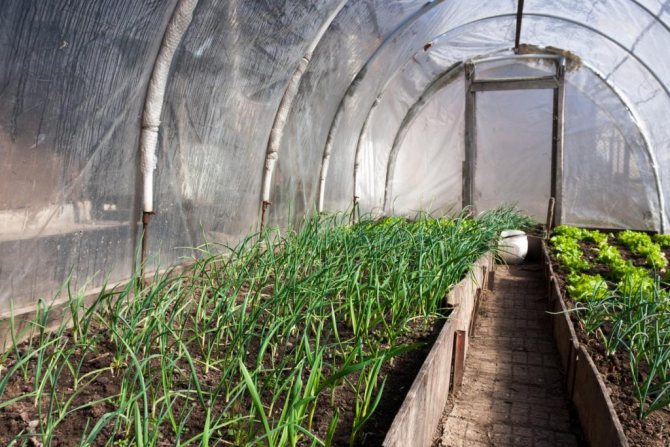

Watering the seed onions
It is not worth reminding that the seedbed with onions is periodically watered.As for the rules, they are the same as when moistening a plant grown on heads. Waterlogging and drying out of the soil is not permissible. Seed onions are watered abundantly during the flowering period. Thus, you can get high-quality large-sized sets. A plot with such onions is usually not mulched, but after each watering it is necessary to loosen the soil.
Application of sprinkler irrigation systems
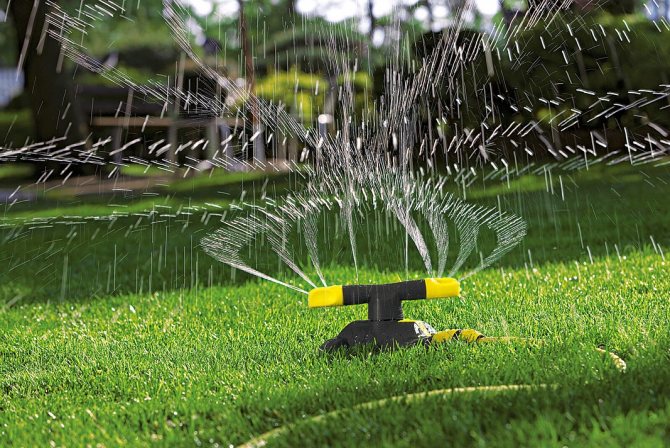

For bows, such systems are considered more suitable. The irrigation head is taken as a basis, which is located in a special installation. Sprinklers are laid underground. When pressure is applied to the pipe when watering is in progress, the rods will move outward. Nozzles are provided at their ends. The sprinkler itself has a height of 5 to 30 cm. Today, there are two types of equipment in retail outlets: rotary and fan. The second option is more suitable for watering onions. Rotary sprinklers often moisten lawns.
Helpful video tips for watering your onions correctly:
Watering green onions in the greenhouse and open field
Precipitation does not enter the greenhouse, so the humidification schedule here differs from that used outdoors.
In the open field, the culture is watered 1-2 times a week (depending on the weather). The soil is soaked to a depth of 10 cm, then the soil is carefully loosened between the rows, which ensures uniform soil moisture and prevents crust formation.
In the greenhouse, the watering schedule is clear, usually every 10 days. Loosening of the soil is replaced by mulching, since the onion planting is more dense under such conditions.
The subtleties of watering onions grown on a feather
Sometimes onions are planted for early greens. The peculiarity of watering such a bed is that soil is moistened more often. In dry weather it is recommended to water the plants 2-3 times a week. Water consumption is 8-9 liters per square meter of the garden.
Expert opinion
Stanislav Pavlovich
Gardener with 17 years of experience and our expert
Ask a Question
Advice! If the bushes are watered at the root, the feathers grow longer.
Regarding the duration of watering, gardeners recommend moistening the soil almost to the first cut of the feathers. To prevent the greens from acquiring a watery state and being stored longer, 4-5 days before cutting, they stop watering the beds.
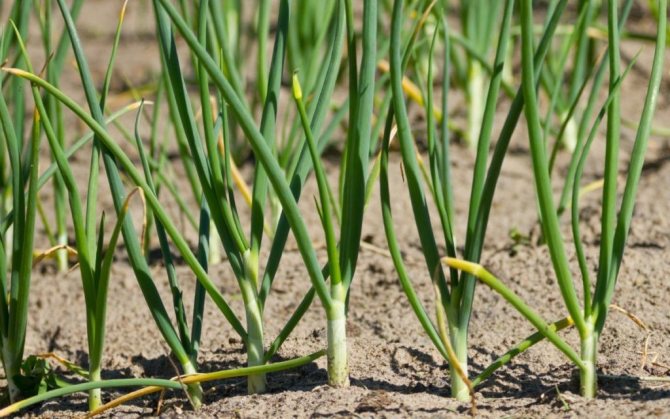

If you want to get an autumn harvest of greens, the seedlings are sown in cold ground and watered abundantly. In order for the plant to take root and the leaves to grow, the earth must be constantly moistened. We must not forget about the lowered temperatures, so the beds are not poured abundantly.
How to water seed onions
There are three methods of growing onions from seeds:
- a two-year cycle in which sets are obtained in the first year;
- growing bulbs from seeds in one year;
- seedling method.
To obtain healthy seedlings, the culture is irrigated 1-2 times a week as it grows. Watering is stopped at the stage of seed bulbs ripening.
Before sowing in early spring, the bed is disinfected with hot water, the seeds are laid out in grooves, sprinkled with humus and covered with a film to retain moisture. The film is removed only after germination. In the future, standard irrigation and feeding are carried out, as indicated earlier.
In the third method, seedlings are first grown from seeds at home. The crops are sprayed so as not to damage the delicate sprouts. After diving into the open ground for the first week, the seedlings are moistened daily for successful rooting. Follow-up care for onions is standard.
How to water onions
In the process of growing onions, you need to decide in advance how to water the onions in the open field. The fact is that onions are susceptible to various diseases and attacks of pests. Which can greatly affect the onion harvest and thus spoil the nerves of the agronomist. Due to most lesions, the onion turns yellow in the garden.Now let's figure out how to water the onions so that the cultivation proceeds without complications. I recommend watering the onion with the addition of the remedy for fungal diseases Fitosporin. Its norms are not regulated in any way and you can make it at least with every watering. For the prevention of diseases, it is more than enough. But there are also folk remedies than watering onions. These include watering onions with salt, it would be more correct to use saline and ammonia. Although I myself do not use salt when watering, I do not admit it, I will still write the doses. But watering onions with ammonia has a very good effect on quality, this has been personally verified. Both of these folk remedies prevent thrips and onion flies. Sprinkle the onion with salt at the root, 200-300 ml each. ready-made solution. Salt solution is prepared at the rate of 150 gr. salt per 10 liters of water. When watering onions with ammonia, a 10% composition is used. 50 ml dissolves in 10 liters of water. ammonia and a ready-made solution, watering onions in the open field is carried out.
Remember one rule that you need to understand when to remove the onion from the garden for storage and stop watering the onion completely a few weeks before. In this case, the onion will be healthy and you can store it for a very long time.
On this I will round off, I hope the note was very informative and I opened a large-scale topic about watering onions in the open field. And now you know how to water onions, as well as how often and with what to water onions for the prevention of diseases and against pests. I would be very happy if my recommendations will allow you to get a good harvest of onions. Share the note on social networks and leave your comments.
Growing onions, at first glance, may seem simple and uncomplicated, but in reality, the process requires adherence to the basic rules of gardening. You need to know how to water onions in the open field, how to process and feed them. The subtleties of agricultural technology allow you to grow a good and high-quality crop. A vegetable needs a lot of moisture, but its excess leads to the development of fungi, so it is necessary to follow the irrigation rules when growing onions.
Features of sprinkler irrigation systems
Sprinkler irrigation is effective for lawn maintenance, greenhouses and large areas of crops.
The installation itself is a system of pipes with water spraying nozzles - sprinklers. The sprinkling effect is created by means of diffusers in the nozzles. Such a device has a more favorable effect on plants, even in comparison with drip irrigation.
Features of sprinkler humidification:
- optimal frequency and rate of watering in any weather;
- there is no risk of soil erosion or soil crust formation;
- not only the root system is moistened, but also the surface layer of air;
- moisture and feeding mixtures are evenly distributed;
- the temperature of the soil decreases, which prevents it from drying out.
The cost of sprinkler irrigation is high, but in the southern regions of our country, its use is economically profitable.
When to start watering?
Watering the onions outdoors is a must. After all, the plant quickly reacts to any changes in the climate and, accordingly, in the soil. If the bulb is in dry and unmoistened soil for a long time, it simply stops growing greens and starts feeding and growing the tuber itself.
For a vegetable, nutritious and moist soil is one of the main conditions for active growth.
Watering the onion is necessary from the moment it is planted in the garden. An important condition is moderate irrigation, since the plant is easily susceptible to fungi that multiply in dampness and excess moisture.
In the spring, it is worth waiting for the sun to dry the earth after the winter period: as soon as greens and herbs appear, watering can be carried out.
Tips & Tricks
To obtain a high-quality harvest, vegetable growers observe some of the subtleties of growing onions:
- To accelerate ripening in the second half of the growing season, the bulbs are uncooked or tugged with partial breakage of the roots.
- In prolonged rainy weather, film canopies are arranged over the onion beds, protecting the culture from getting wet. This is especially true in August.
- Water the vegetable evenly, otherwise low-quality bulbs will form with alternating juicy and dry scales, which will adversely affect the shelf life of the crop.
Useful tips for watering onions
To get good yields of green or onions, you should heed the recommendations of experienced gardeners:
- do not irrigate under the scorching sun - the moisture will quickly evaporate without moistening the soil, and the plants will get burned;
- irrigation should be carried out along the grooves dug along the plantings at a distance of 10 cm or in the aisles;
- when the green onions lay on the garden bed, and the feathers turn yellow, it means that the harvest time has been missed, this leads to a loss of harvest;
- onion ripening takes 3-4 months, and watering of the plantings is stopped a month before harvesting;
- to accelerate the ripening of onions, you need to slightly lift the layer of soil under the bulb with a shovel or pitchfork - this leads to undermining of the roots and stops saturating the root system with moisture;
- in rainy weather, a canopy made of film can be arranged over the onion plantings, protecting the onion from excessive wetting;
- in regions with frequent rains and high humidity, onion beds are raised above the soil level;
- loosening onion beds will reduce moisture evaporation, which means it will reduce the frequency of irrigation;
- do not break onion feathers - water can get inside and harm the bulb, which will affect the quality of storage;
- changes in soil moisture from drought to bay will lead to alternation of dry and juicy layers inside the bulb, which will significantly reduce the shelf life, and the quality of the crop will be low.
You will be interested to know how and where you can store onions in your apartment.
Correct organization and timely watering of onions is a guarantee of high and high-quality yields. It must be remembered that onions require moderate soil moisture, and try to avoid both lack and excess of moisture.
When is watering not required?
Gardeners' recommendations when it is not necessary to water the beds with onions:
- At least one week before harvest. This is a prerequisite. The vegetable must be removed from the soil dry, then it will be stored longer. If the weather is rainy and there is a threat of crop loss, the wet bulbs are dried in a dry and well-ventilated area.
- Opinions differ as to whether to water the onions in August. By this time, irrigation should be reduced, but it is not recommended to completely stop it. Lack of moisture at the last stage of onion ripening can affect the taste of the root crop.
- You need to keep an eye on the nearest weather forecasts. Bad weather can disrupt plans for harvesting or feeding. It is worth fertilizing plants with mineral preparations a few days before the expected rainy period. Thus, the nutrients will have time to be absorbed by the root system and their concentration will correspond to the required rate.
- A lot of moisture in the soil is not required for the crop, so watering should be special at all stages of the growing season. When planting, it is important to regularly irrigate the beds so that the bulb wakes up and grows actively. During the ripening period, it requires less moisture, so the amount of watering is reduced. Immediately before harvesting, the soil is completely moistened.
What dacha does not grow onions, no matter for a turnip (head) or a feather (greens)? However, not every gardener can boast of large and juicy bulbs. This is understandable: after all, in order to get the most from the culture, you need to take care of it, including watering correctly.
Next, let's talk in more detail about how to water onions after planting in open ground, as well as when all watering should be stopped in order to get a rich harvest.
Why is it important to water the onions in a timely and correct way?
Any plant needs moisture for good growth and normal development. Naturally, onions are no exception.
However, as with any business, there is always a balance to be struck. Therefore, in no case should the onion be allowed to dry out due to lack of moisture, as, indeed, turn the onion bed into a swamp.
Note! Drought for onions is a signal that it is time to pump up the growing season, in other words, if you do not water the onion during its growth, then the bulbs simply will not gain weight and remain small.
In addition, with insufficient watering during the growth period, the onion becomes more bitter.
And due to excess moisture, especially at the end of the growing season, if you continue to water the onions, the bulbs may simply become watery or begin to rot.
Drip irrigation
Of course, drip irrigation is ideal for watering all vegetables. Yes, onions are a relatively moisture-loving crop, but few people grow them on such a scale that it is reasonable to use drip irrigation.
It's another matter if you grow onions for sale. However, this is a completely different story: here we are talking about amateur gardening.
Mulching
Instead of installing expensive drip irrigation, it is much easier to simply mulch your onion beds. Then not only will you not have to water the onions often, but you will also practically get rid of such procedures unloved by all summer residents as loosening and weeding from weeds.
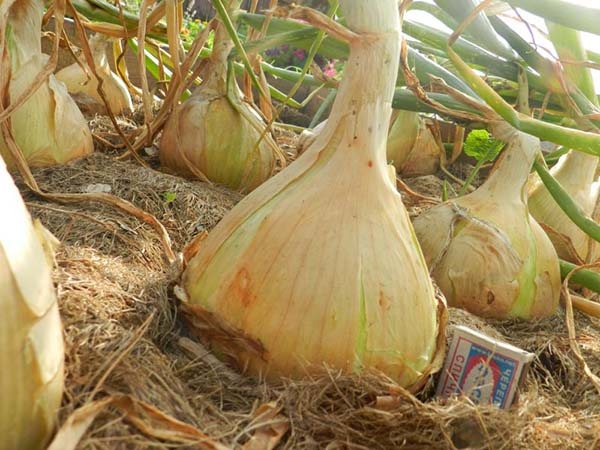

If you grow without mulching, then after each watering, it is advisable to loosen the ground and periodically weed (read about the nuances below), and the weeded grass can be left right on the garden bed, it will play the role of mulch in the future.
Loosening and weeding
If you do not mulch the beds, then you will need to periodically loosen and weed between the bulbs in order for the plant to receive enough oxygen necessary for development.
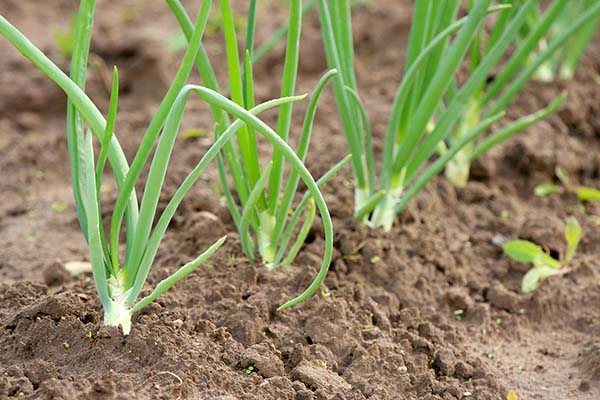

This event is also needed in order to so that a dense earth crust does not form on the surface, which does not allow moisture and all the same oxygen to flow evenly to the plants.
Periodically loosening should be combined with weeding in order to eliminate fast growing weeds.
Advice! Once the bulbs have reached medium size, you will need to gradually start scooping up soil from them, which will help them grow in size and ripen quickly.
Watering features
Like any vegetable crop, onions require specific care. Irrigation plays an important role in this matter.
Experienced gardeners determine the time and amount of sprinkling based on the condition of the soil. Recommendations on how to properly water the onion:
- The soil should be moderately moist.
- Drying and waterlogging of the earth should be avoided.
- In order to determine how moist the soil is, you need a thin dry wooden torch. It is stuck into the ground to a depth of at least 10 cm and then they look to see if soil particles remain on it or if it is completely dry.
At the beginning of growth
At the first stage of growing, irrigation of a young plant should be timely and special. Its specificity is as follows:
- Water for irrigation at the beginning of growth should be warm and settled. It is not worth heating it on purpose. If the days are sunny and warm, it is enough to collect water in a container and leave it in the sunlight. Possible precipitation will sink to the bottom, and the liquid itself will be heated to the required temperature.
- There are standard norms for how much water to pour on the beds at the initial stage of onion growth. 10 liters of liquid are used per 1 m² of land. The number of irrigations and their volumes depend on the weather and soil conditions.
- Growing onions on a feather has its own characteristics. It is important when watering to ensure that no water remains between the feathers. Otherwise, the greens will start to deteriorate.
- To prevent the green mass from getting burns from the sun's rays, irrigation is carried out in the morning or evening.
- The irrigation system is different for each grower. If the grooves between the rows are filled with water, it is important to monitor the pressure from the hose and the initial moisture content of the soil. Strong pressure can strip the bulbs and wash out the soil. Root crops will start to disappear.
- The first watering is carried out immediately after planting. During irrigation, liquid fertilizers are applied, which allow the bulb to take root faster and adapt to the soil.
Garlic watering mode
So, how often to water the onion and how much water to use at the same time, we found out with you. Now let's figure out how to properly moisten the soil in garlic beds. The root system of this plant is rather weak. In addition, the heads of garlic are smaller than onions and nutrients are drawn mainly from the upper layers of the soil. Therefore, this plant needs a little more water. However, you cannot pour garlic, as well as onions.
The green parts of this culture begin to develop intensively in late April - early May. During this period, at least two waterings should be done. But only if the weather is dry. In late spring - in June, garlic heads begin to grow actively. At this time, it is watered at least once every 5 days, and in very hot windy weather - once every 3 days.
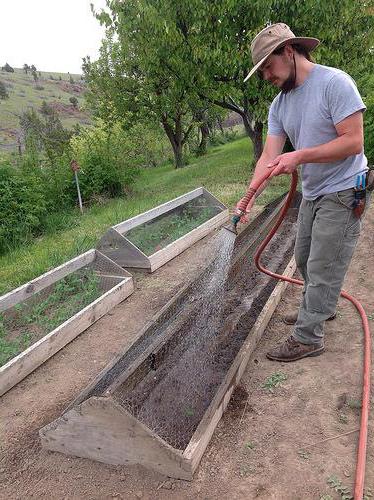

The answer to the question of how often you need to water onions and garlic depends primarily on the weather during the growing season. In a rainy summer, the soil in the garlic beds is watered much less often - as it dries. Sometimes in the beds with this plant, you even have to make grooves to prevent stagnation of water.
When and how much to water onions
The homeland of onions is Southwest Asia - a place where drought alternates with rain, heat and frost. Wild onions grow in the meadows and steppes of this region. In spring, it receives abundant moisture, ripens in drought, carries seeds in anticipation of new rains.
With proper watering, the number of fruits increases significantly
If domesticated onions are not watered at all, they will grow like wild ones - small and very bitter. If it is watered too abundantly, it will rot.
Onions have a shallow root system, which explains the increased requirements for air and soil moisture. But these requirements are not the same at different stages of growth.
After sowing, the onion needs moisture especially during the first two weeks. Within 2-3 weeks after emergence, it also needs a lot of moisture. This is due to the fact that it is during this period that the active phase of growth and development of the root system begins. However, there should be no excess moisture - this will negatively affect the maturation of the heads. So, the plant needs moderate watering after planting and germination.
In the first 60 days after planting, the onions must be watered: if there is not enough moisture, it forms only 3-4 leaves, small bulbs are formed, and the plant hibernates. And nothing can bring him out of this state.
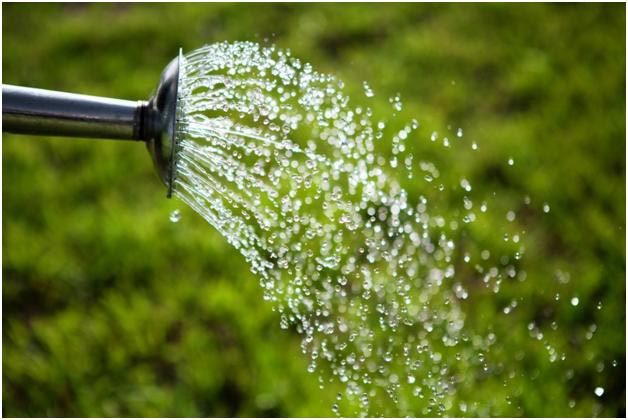

The amount of harvested fruits depends on watering, as well as their quality: juiciness, softness and taste
Moreover, unlike other vegetables (cabbage, cucumbers), onions do not need daily watering. Twice a week is enough. This is quite convenient for those who come to their summer cottage on weekends: you can water the onions on Friday and before leaving on Sunday.
For watering, you need to use exclusively warmed water, settled in a barrel for a day, but in no case cold. The soil must be moistened carefully, between the rows of the plant, in specially made grooves. But not directly under the bulb and not along the leaves - this should never be done if you do not want to infect the plants with oversporosis - downy mildew, which usually happens when the soil is waterlogged.
Most varieties of culture begin to form bulbs from the second half of summer.In central Russia, this period roughly coincides with the Orthodox holiday - the day of the supreme apostles Peter and Paul - July 12. From this time (about a month before harvesting), the onions do not need moisture. This is due to the climatic conditions of the homeland of onions - Central Asia, where just at such a time there is a very hot and dry weather. Under such conditions, at this time, the bulb is formed tasty, high-quality, contains enough dry matter and sucrose. Thanks to them, onions are better stored. Good storage of this healthy product, of course, depends on the variety and on the growing conditions. If summers are dry and hot, more sucrose and dry matter accumulate in the bulb. The rest of the factors are in the power of the person: this is the observance of the sowing time, the irrigation regime, and nutrition.
The maturation of the plant, or rather its speed, also depends on watering.
Watering the onions is best before or immediately after weeding. You can independently check the required frequency of watering the onion - by dipping your fingers into the soil. If the soil is wet at a depth of one finger phalanx, then you should not rush to watering. If it is loose and dry, then it's time to moisturize.
The main regulator of irrigation frequency is weather conditions. If the humidity is high, you do not need to water the onions. If the weather is steadily hot, it is watered every three to four days. During the formation of the bulb, excessive moisture leads to the fact that the fruits begin to crack. To avoid this, different planting methods are used in different regions of onion cultivation. Where the humidity is high, onions are planted in the beds, ridges, where it is arid - under normal conditions. If the husks on the bulbs are cracking, this indicates sudden changes in humidity. This often happens when heavy rains begin to fall after a drought.
If onions are grown for seeds, they are watered during flowering.
For better watering, you can carry out a drip irrigation system, which will improve soil moisture, and, accordingly, accelerate plant growth.
So, watering onions during the growing season:
| June | Early to mid-July | Mid to late July |
| Frequency - once every 8-10 days. It needs to be used for 1 sq. meter of area 10-12 liters of water. | The same frequency as in June. However, the amount of water is reduced to 8 liters per 1 sq. meter. | Watering frequency - once every 4-5 days. We reduce the amount of water to 5-6 liters per 1 sq. meter. |
Combining onion watering with feeding
Often, many gardeners combine watering with liquid fertilizing.
Important! However, even before liquid top dressing, it is first recommended to water (about a day or a couple of hours), and in the case of sprinkling, after top dressing, sprinkle the onion feathers with clean water.
Very often at the beginning of the growing season, onions watered with salt water (1-2 tablespoons per 10 liters of water) in order to prevent the appearance of onion flour (due to its activity, the tip of the feather turns yellow and then dries up) and scaring away other insect pests, so as not to let them lay eggs, of which then the larvae will hatch.
Many gardeners are afraid to do salt treatment because they are afraid to salt the soil and spoil the taste of the turnips. However, if the plants are watered with a solution of the specified concentration, then you will not cause any harm.
Note! Contrary to popular misconception, the ripening rate of onions from watering with salt does not increase.
As you can see, watering onions is not that difficult. The main thing to remember is after landing and to a slightly lesser extent during growth and development, the soil in the garden should be barely wetand when the bulbs start to ripen and during the last 2-3 weeks before harvest - dry.
Video: how often to water onions

